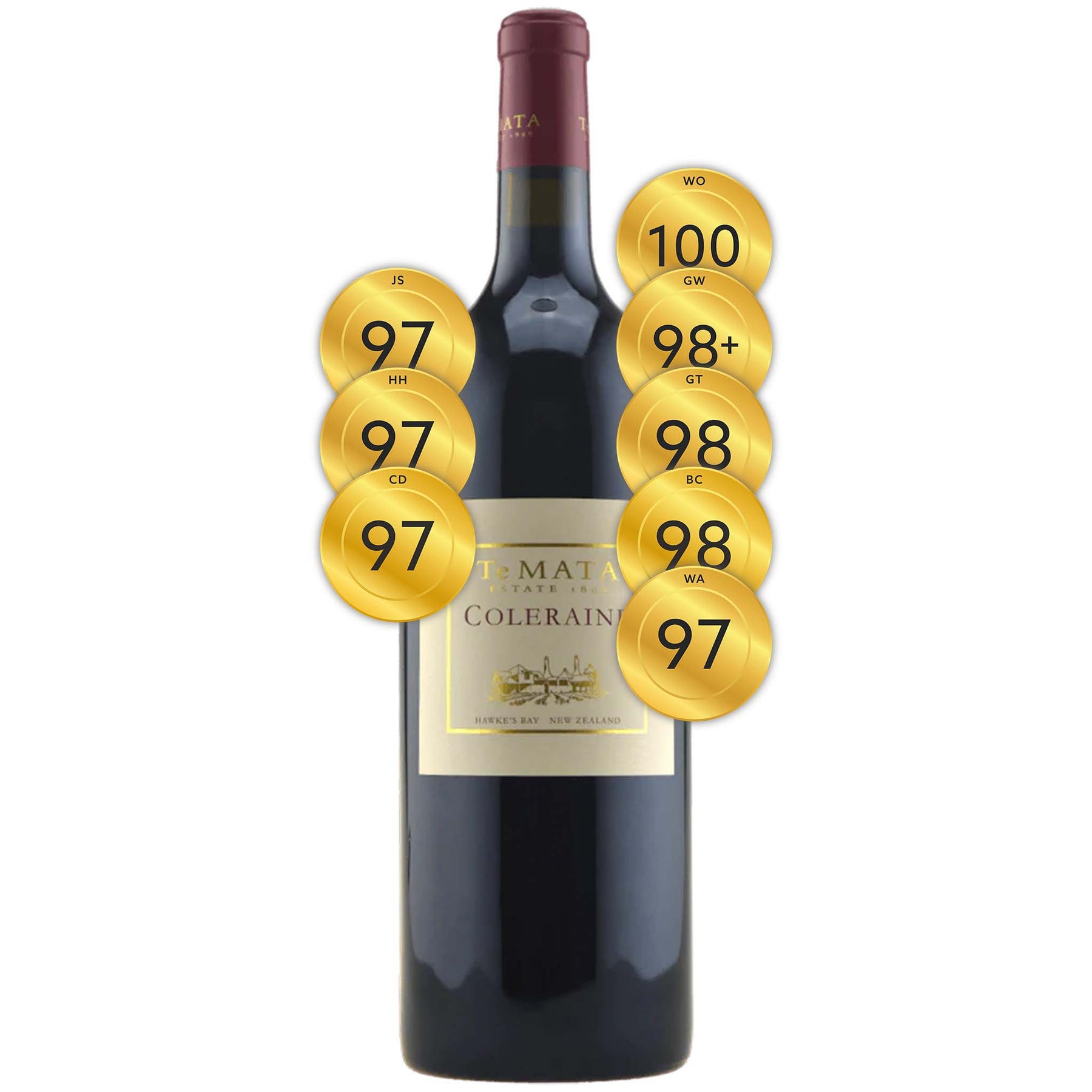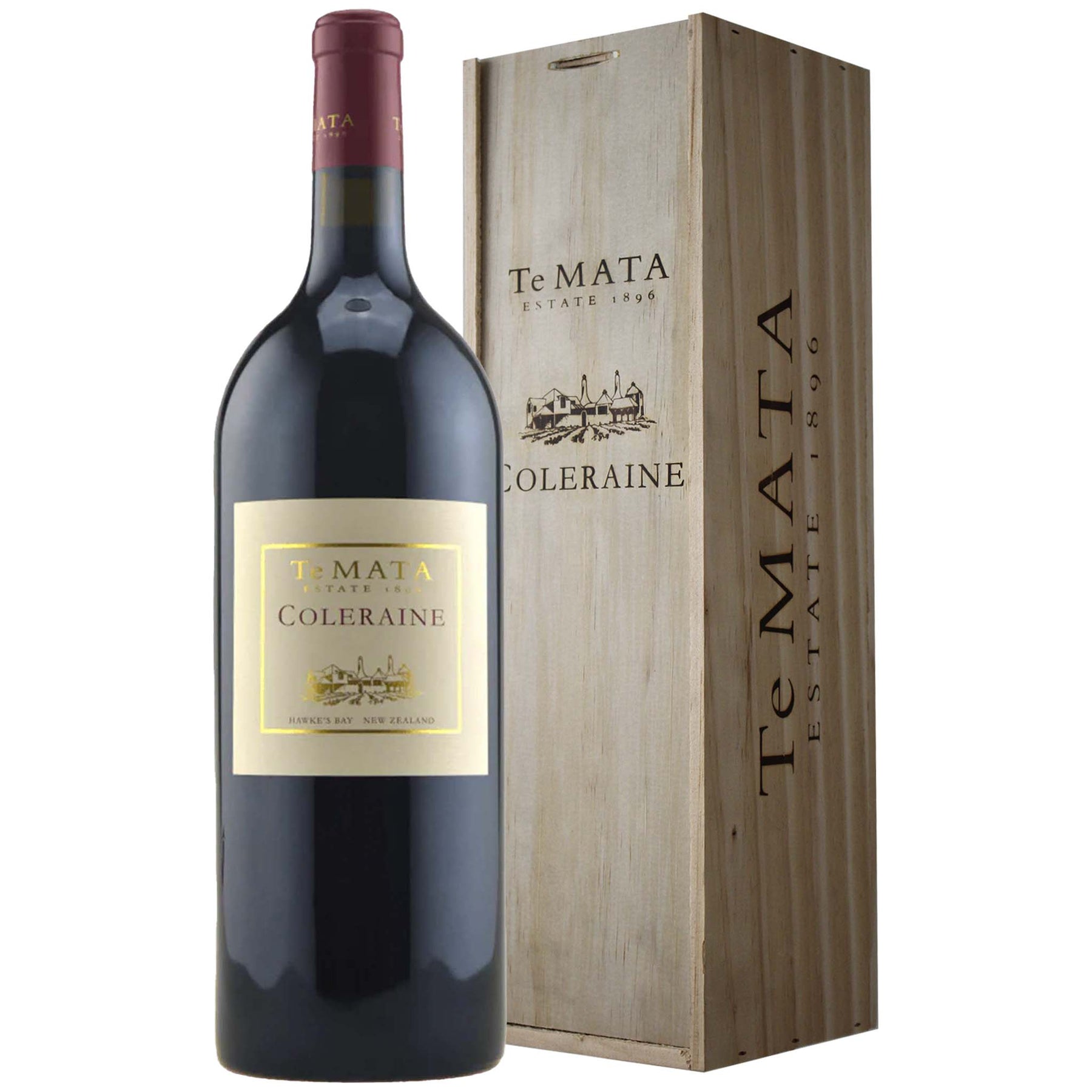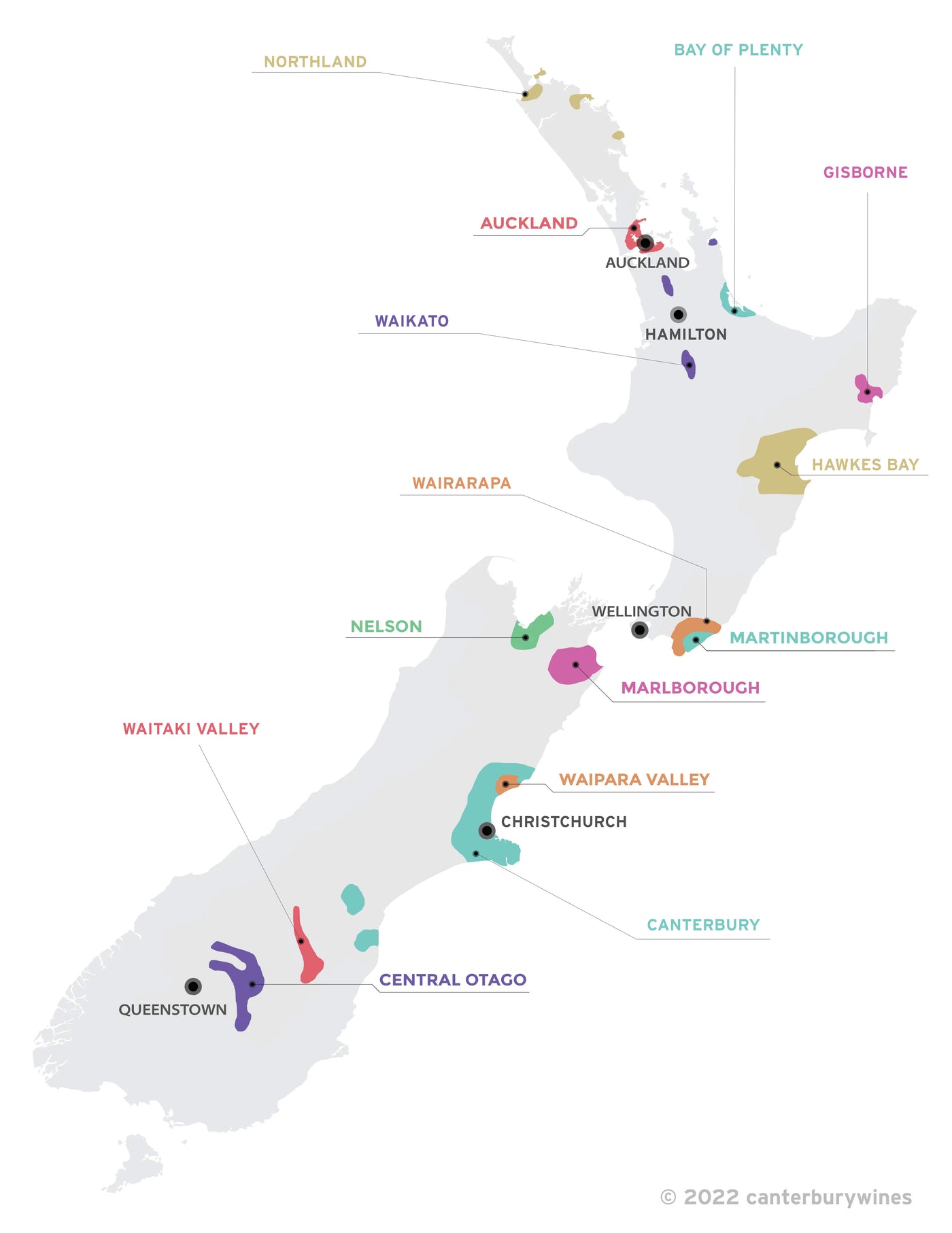


Te Mata Estate Coleraine 2020 (1500ml)
Style: Red Wine
Closure: Cork
Te Mata Estate Coleraine 2020 (1500ml)
Warehouse
34 Redland Drive
Vermont VIC 3133
Australia
Critic Score: 100
Alcohol: 14.0%
Size: 1500 ml
Drink by: 2070
Te Mata Estate was acquired by John Buck in 1974 and the Buck family have been producing Te Mata wines ever since. Coleraine is named after John's family ancestral hometown in Northern Ireland. Coleraine is Te Mata Estate's flagship wine and is regarded by many as New Zealand's finest red wine. First produced in 1982, Coleraine is a classic blend of cabernet sauvignon, merlot and cabernet franc.
"Unbelievably good. Young, but the potential is overwhelmingly potent. Tight, medium-bodied, so concentrated, but light too, ultra-mineral, fresh, all the gravel and tense cabernet feel, but with perfume unlocked: so flagrant and fragrant. The length is superb. I'm taken aback by the beauty and essence-like nature of this wine. My precious. Easily one of the best wines I've tasted in the last decade." Gary Walsh
The 2020 Coleraine is arguably the finest release to date. It comprises 57% cabernet sauvignon, 36% merlot and 7% cabernet franc.
"If the Langton's Classification crossed the Tasman, Te Mata Coleraine would sit alongside Grange at its very pinnacle. Established, esteemed, outstanding – vintage after vintage, the glowing adjectives come thick and fast." Langtons
"A gleaming obsidian-dark, Coleraine '20 flashes in the glass. From its depths glimmers wild roses and cedar, blackcurrants, dark cherries, plums – a rapid symmetry of perfectly ripe dark fruit. Notes of cocoa-nib, thyme, and layer upon layer of fine tannin are polished to a mirror-finish, shimmering the length of the wine. From its elevated aromatics to its monumental mid-palate weight, intense vitality, and long radiant finish, Coleraine '20 is a window on midnight. Replete in detail. Out of darkness emerges an immense wine of clarity, concentration and focus. Coleraine 2020 is a perfect vision.
Each parcel of grapes was destemmed before a traditional warm, plunged fermentation and extended maceration on skins. The resulting wines were then run to predominately new French oak barrels for 17 months' maturation. Throughout this time, they were regularly topped and racked. The assemblage was made in January 2021. The finished wine was bottled in December 2021." Te Mata Estate
Te Mata Estate Winery
Expert reviews
"This is solidly built yet fine and flawless with cassis, scented floral, olive, cake spice and stylish oak aromas on the nose. The powerfully concentrated palate offers dazzling clarity of fruit purity as well as astonishing complexity, brilliantly structured by perfectly pitched chalky tannins. Beautifully layered with formidable depth and seductive texture, making this rendition of Coleraine undeniably spellbinding. At its best: 2030 to 2050." Sam Kim, Wine Orbit - 100 points
"Unbelievably good. Young, but the potential is overwhelmingly potent. Floral, nutty, intense small-berried fruit, cedar, anise and sweet herb. Tight, medium-bodied, so concentrated, but light too, ultra-mineral, fresh, all the gravel and tense cabernet feel, but with perfume unlocked: so flagrant and fragrant. The length is superb. I'm taken aback by the beauty and essence-like nature of this wine. My precious. Easily one of the best wines I've tasted in the last decade. Drink : 2024 - 2045+." Gary Walsh, The Wine Front - 98+ points
"Superbly structured and concentrated, this is the most impressive Coleraine to date. Layer upon layer of beautifully ripe tannins support the densely fruited palate yet the wine retains cabernet's hallmark crispness and poise. Brilliant." Gourmet Traveller Wine 2022, Top New Releases – 98 points ★★★★★
"A blend of cabernet sauvignon 57% , merlot 36% and cabernet franc 7% . A deeply-tinted, almost inky wine with layers of sumptuous fruit and savoury characters, including cassis, red rose, dark chocolate, hedgerow, anise and nutty oak. A generously proportioned, youthful red that is already surprisingly accessible but promises to age gracefull. Drink: 2022–2046." Bob Campbell MW, The Real Review - 98 points
"The 2020 Coleraine is seriously structured, dark and spicy, with great concentration and gravitas. The tannins are so integrated and woven that they feel almost imperceptible. This is spicy and resinous and charry, but its fine and graphite and mineral too. Chalky tannins plume through the supple fruit. Very cool. It's exciting, plush, open weave and sensational. Drink: 2023-2040." Erin Larkin, Wine Advocate - 97 points
"Very deep, bold, bright purple/red colour, the aromas similarly impressive for their concentration and vibrancy. The wine is super-concentrated and loaded with drying, savoury tannins that add a smidgin of bitterness that helps cleanse the aftertaste, which is formidably long. A sensational cabernet blend, gorgeously flavoured and perfumed, profound and lingering. It has the intensity and structure to age long-term. The patient will be handsomely rewarded. Drink: 2025–2045." Huon Hooke, The Real Review - 97 points
"This wine lives up to its reputation with this example. Opaque at the core with deep purple hues and a ruby pink rim with ink staining tears. An excellent bouquet of pure blackberry and doris plum scents, layers of black cherry and iron sand earthy qualities. Oak layers in myriad aromas from clove to vanilla and a toasty smoke layer with a sweet lift from new barrel. A stunning wine on the palate, taut and new with firm chalky tannins, backbone of acidity, olive and garrigue with a core of fleshy dark fruit flavours soaking up the new energy from barrel. Layers of baking spice and tobacco with a warmed earth mineral quality. This is the most impressive example of Coleraine to date. Best drinking from 2026 through 2040+." Cameron Douglas MS - 97 points
"A beautiful nose of graphite, blackcurrant, crushed stone, blackberry, bark and sage. Medium- to full-bodied with velvety, structured tannins. Linear onto a wide open palate with so much clarity and length. Mineral complexity sits underneath the wonderfully ripened black fruit giving definition and dynamics. Steady acidity. Fresh herbs and black tea. Pine, too. So attractive now but needs time. Best after 2026." James Suckling, JamesSuckling.com - 97 points
The story of coleraine

Te Mata Estate was acquired by John Buck in 1974 and the Buck family have been producing Te Mata wines ever since. Coleraine is named after John's family ancestral hometown in Northern Ireland.
"Coleraine is New Zealand's greatest red wine" - Sydney Morning Herald
Coleraine is Te Mata Estate's flagship wine and is regarded by many as New Zealand's finest red wine. First produced in 1982, Coleraine is a classic blend of cabernet sauvignon, merlot and cabernet franc, and displays the concentration, complexity and elegance found in the world's greatest wines. Coleraine showed the world that Hawke's Bay, and indeed New Zealand, was capable of making world class red blends.
Cabernet Sauvignon is nearly always the dominant grape variety but the blend has ranged from 94% Cabernet Sauvignon in 1982 down to just 25% in 2002. The remainder of the blend is predominantly Merlot with, usually, the addition of small amounts of Cabernet Franc.
The earlier vintages of Coleraine from 1982 to 1988 were all single-vineyard blends from the Coleraine vineyard. From 1989 onwards, the wine has been a blend of grapes from across the Te Mata Estate vineyards that were planted in 1982.
Peter Cowley joined Te Mata as their sole winemaker in 1984, two years after Coleraine's inaugural vintage. He has been responsible for all the subsequent vintages until his retirement in 2019. Peter handed over the reins to now senior winemaker Philip Brodie, who has been part of the Te Mata Estate team since 1992.
"The absolute strength of Bordeaux blends is in different varieties and different soils, and that's where we started. But it is also really about the people that put these wines together, who made them what they are.
Although it might have been inspired by Bordeaux, the thing about Coleraine is that it has really come out of that shadow and it has developed its own voice and style in that time. When you go through 32 years of Coleraine, we are looking at New Zealand history – we are stepping out of the shadow of Bordeaux and taking pride in New Zealand." Toby Buck, Te Mata Estate
Nick Buck discusses Coleraine
About the winery

Te Mata Estate was established in 1896, specialising in high-quality wines of classical style. The winery remains family owned, producing internationally recognized wines exclusively from its Hawke's Bay vineyards.
"New Zealand's first growth" - Andy Howard MW, Decanter Magazine
"A national treasure" - Jancis Robinson MW
"New Zealand's greatest winery" - Robert Parker's Wine Advocate
Te Mata Estate was originally part of Te Mata Station, a large pastoral land-holding established by English immigrant, John Chambers, in 1854. After returning from France, John Chamber's third son, Bernard, had the idea to plant vineyards on the north-facing hills around Havelock North. In 1892 he planted vines on three parcels of hillside land above the homestead and began converting the original stables to ferment and mature the wines. The first vintage wines were released in 1986. Today, Te Mata Estate still uses those same three vineyards.
The Chambers family sold the property in 1919. The property had two other owners until John and Wendy Buck acquired Te Mata Estate in 1978 and instigated a twenty-year development program, which commenced with the restoration of the original winery building and the replanting of all of the original vineyards. In addition, new vineyard sites were acquired in the Bridge Pa, Gimblett Gravels and Dartmoor Valley sub-regions of Hawke's Bay (refer map below). The Buck family have been producing Te Mata wines ever since. The success of Te Mata's wines in the '80s is credited with sparking the revival of Hawke's Bay as a top wine region.

Te Mata Estate Winery and Hawke's Bay sub-regions

New Zealand
New Zealand is home to more than 700 wineries across 14 wine regions. The regions are Auckland, Bay of Plenty, Canterbury, Central Otago, Gisborne, Hawkes Bay, Marlborough, Martinborough*, Nelson, Northland, Waikato, Waipara Valley, Wairarapa and Waitaki Valley. * Martinborough is a sub-region of Wairarapa, however, as it is world renowned it is considered here to be a region to avoid confusion.
The wine regions in New Zealand stretch from latitudes 36°S (Northland) in the north (comparable in latitude to Jerez, Spain), to 45°S (Central Otago) in the south (comparable in latitude to Bordeaux, France). New Zealand's climate is maritime, producing cooler summers and milder winters than would be expected at similar latitudes in Europe.
Viticulture in New Zealand dates back to 1836 when British resident James Busby produced wine in the far north, but it wasn't until 1985 that the wine industry came of age when Cloudy Bay Sauvignon Blanc garnered international attention and critical acclaim.
New Zealand is internationally renowned for Sauvignon Blanc (particularly from Marlborough), Pinot Noir (Central Otago, Martinborough and Waipara Valley), Chardonnay, Bordeaux-style blends of mainly Merlot and Cabernet Sauvignon (Hawkes Bay) and Syrah (Hawkes Bay). Sauvignon Blanc accounts for 63% of the area of the national vineyard, followed by Pinot Noir (14%), Chardonnay (8%), Pinot Gris (7%) and Merlot (3%).



